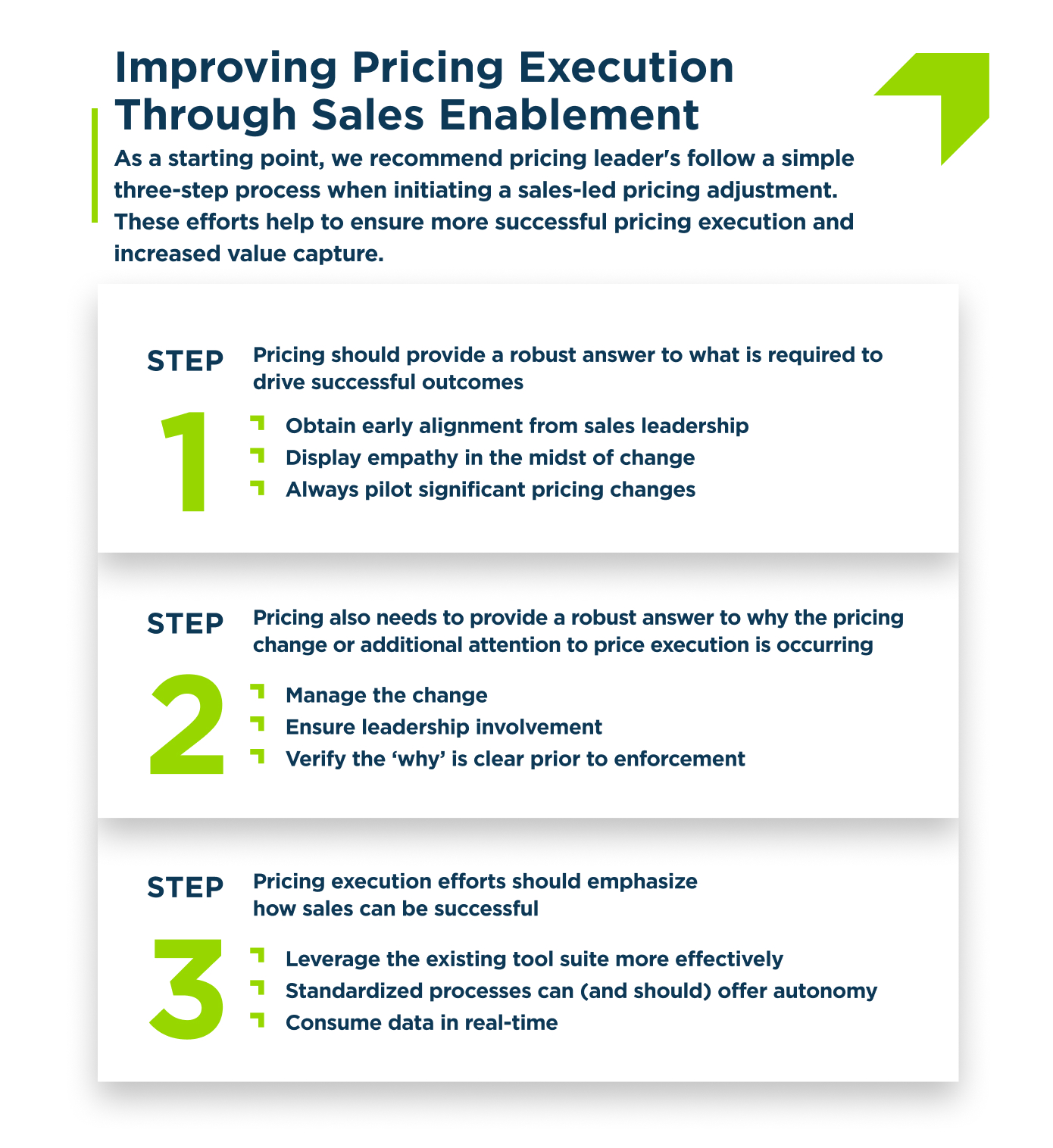The relationship between pricing and sales has long been discussed. On the surface, the goals of these two teams are often considered opposed; pricing wants to raise prices and sales wants to bring in customers to hit a revenue-based quota. Pricing operates in a black box, and Sales operates inconsistently across reps and geographies. Although these narratives lack sufficient nuance, they do reference an important truth: success between these two disciplines requires a leader with emotional intelligence and behavioral awareness.
I spoke with my colleague, Bill Piacitelli, Cortado Group’s Sales Practice Leader on this topic. The first thing that Bill noted was that “salespeople are naturally skeptical, and change is usually pretty hard”. This comment informed our subsequent discussion which delved into how pricing can be most effectively implemented when collaborating with sales.
In fact, as our discussion progressed, we uncovered a simple three step framework that may serve as useful reference when considering how to improve pricing execution, whether a result of underperformance or simply a change to the price sheet.

Step 1: Pricing (the team or leader responsible) should provide a robust answer to what is required to drive successful outcomes; this cannot be glossed over to save time or effort.
When an organization’s structure does not support the appropriate collaboration between pricing and sales, decisions can be made in a vacuum (inadvertently or otherwise).
The pricing team should develop a clear rollout plan; within this plan, it should specify what is expected and how the change is intended to be beneficial.
Bill highlighted three best practices to consider:
1. Obtain early alignment from sales leadership
There are several benefits to this. First, it is easier to gain buy-in from the broader sales team when a respected leader has provided their endorsement. Second, this also helps in the development of a better “answer,” whether that’s related directly to the price levels, how customers are segmented, or in the execution plan itself.
2. Display empathy
A pricing execution program, at its core, is a change management exercise. By leading with empathy, and acknowledging that the change may be difficult, pricing leaders can start to erode the skepticism that some sales stakeholders may feel.
3. Always pilot significant pricing changes
From the pricing lens, this may be an activity that you already thought about. But, pricing’s motivation may have simply been to capture additional market feedback to further optimize the price levels before a broader rollout. This is completely valid, but incomplete.
Step 2: Pricing also needs to provide a robust answer to why the pricing change or additional attention to price execution is occurring.
Pricing changes can be disruptive, and at face value, may not seem necessary. Certainly, if a seller is hitting or surpassing their number, change can even be perceived as adverse to their efforts.
Ultimately, it is incumbent on Pricing to ensure that downstream stakeholders have the visibility required to be successful.
Bill highlighted three best practices to consider:
1. Manage the change
Not only does the sales team need to be brought into pricing in general, but sales also needs to be on board when executing a price change. This is, at its core, just like any other change management effort. Make it as easy as possible for the recipient to navigate the change.
2. Ensure leadership involvement
Information on the pricing change should come directly from impactful leaders in the organization. Of course, this can include the C-suite, but it can also include advocates of the change who enjoy informal authority (e.g., an experienced, respected sales manager).
3. Verify the ‘why’ is clear prior to enforcement
Given how pivotal pricing execution is in a company’s realization of its revenue goals, leaders must be certain the ‘why’ has been sufficiently communicated prior to enforcement. If sales feels that pricing is being enforced without any rhyme or reason, it is unlikely outcomes will improve.
Step 3: In addition to a rollout plan, pricing execution efforts should emphasize how sales can be successful.
It is very common for companies that have a sound pricing model and price sheet to not realize their pricing goals. This is often the result of sellers not having sufficient context and/or training on pricing to engage effectively with both new and existing customers. This often results in “price leakage” from tactical—not strategic—discounting that unnecessarily erodes profitability.
Cross-functional collaboration is often necessary to develop the required processes and tools that support profitable pricing decision-making.
Bill highlighted three best practices to consider:
1. Leverage the existing tool suite more effectively
Every customer relationship management (CRM) software should have reason codes, but don’t stop there. Add a required detail section to explain why the selected reason code was chosen. Another example is with a configure price quote (CPQ) software; there is often additional out-of-the-box functionality available to add pricing guidance at time of quote.
2. Standardized processes can (and should) offer autonomy
For generic scenarios which often represent >80% of deals, generate sales plays that can be followed. For scenarios that are truly unique, ensure sales is equipped to make an informed decision and that there is a pathway to provide feedback. There are many reasons why a pricing exercise may not nail it on the first try (e.g., bad data).
3. Consume data in real-time
As a sales leader, leveraging data to obtain real-time insights on deals can be tremendously valuable. This has myriad benefits including the ability to provide sales rep coaching as well as to measure pricing performance. A basic example of this is setting up a CRM notification for any closed/lost deals.
My discussion with Bill reinforced how vital collaboration between sales and pricing leaders is in ensuring successful pricing execution. At Cortado, our approach to pricing execution always includes sales excellence and enablement for a reason—both are paramount to realizing profitable pricing outcomes. Further, by embedding sales in our pricing execution work, we increase speed to impact and achieve a more durable change.


